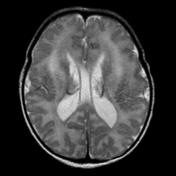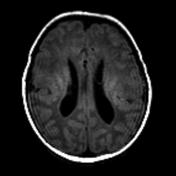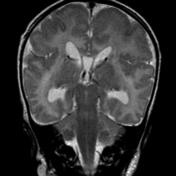Cerebrohepatorenal syndrome (Zellweger syndrome)
Updates to Case Attributes
Neonate with seizures.
myelination of the cerebellum and brainstem is within normal limits-
ventricles are dysmorphic withmild dilatationparallel alignmentpatent cavum septum pellucidum and vergae
corpus callosum is present and appears intactpolymicrogyria within the sylvian fissures, including the posterior margins of the insular cortexhippocampi are somewhat dysmorphiclack of the usual T2 hypointensity of myelination in the posterior limbs of internal capsulegerminolysis-pseudocyst formation: cysts are shown at the caudothalamic grooves within both lateral ventricles
Conclusion
Main abnormalities are dysmorphic ventricles with pseudocysts and the presence of cortical polymicroygyria in the sylvian fissures and insular cortex. In addition, there is lack of myelination in the posterior limbs of internal capsule.
Appearances would be entirelyare in keeping with the clinical suspicion of Zellweger syndrome.
-<p>Neonate with seizures.</p><ul><li>myelination of the cerebellum and brainstem is within normal limits</li><li>ventricles are dysmorphic with<ul><li>mild dilatation</li><li>parallel alignment</li><li>patent cavum septum pellucidum and vergae</li></ul></li><li>corpus callosum is present and appears intact</li><li>polymicrogyria within the sylvian fissures, including the posterior margins of the insular cortex</li><li>hippocampi are somewhat dysmorphic</li><li>lack of the usual T2 hypointensity of myelination in the posterior limbs of internal capsule</li><li>germinolysis-pseudocyst formation: cysts are shown at the caudothalamic grooves within both lateral ventricles</li></ul><p>Conclusion</p><p> Main abnormalities are dysmorphic ventricles with pseudocysts and the presence of cortical <a href="/articles/polymicrogyria" title="Polymicrogyria">polymicroygyria</a> in the sylvian fissures and insular cortex. In addition, there is lack of myelination in the posterior limbs of internal capsule. </p><p>Appearances would be entirely in keeping with the clinically suggested <a href="/articles/zellweger-syndrome" title="Zellweger syndrome">Zellweger syndrome</a>. </p>- +<p>Appearances are in keeping with the clinical suspicion of <a href="/articles/zellweger-syndrome">Zellweger syndrome</a>.</p>
Updates to Study Attributes
- myelination of the cerebellum and brainstem are within normal limits
-
ventricles are dysmorphic with
- mild dilatation
- parallel alignment
- patent cavum septum pellucidum and vergae
- corpus callosum is present and appears intact
- polymicrogyria within the Sylvian fissures, including the posterior margins of the insular cortex
- hippocampi are somewhat dysmorphic
- lack of the usual T2 hypointensity of myelination in the posterior limbs of the internal capsule
Conclusion
Main abnormalities are dysmorphic ventricles with pseudocysts and the presence of cortical polymicroygyria in the sylvian fissures and insular cortex. In addition, there is lack of myelination in the posterior limbs of internal capsule.
Image MRI (T2) ( update )

Image MRI (T1) ( update )

Image MRI (T2) ( update )

Updates to Study Attributes
.Germinolysis-pseudocyst formation: cysts are shown at the caudothalamic grooves within both lateral ventricles
Image Ultrasound ( update )








 Unable to process the form. Check for errors and try again.
Unable to process the form. Check for errors and try again.